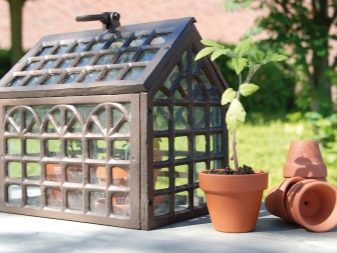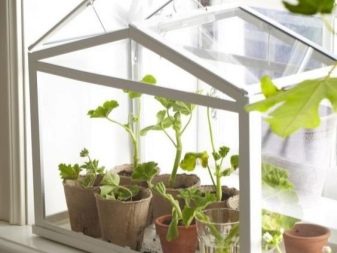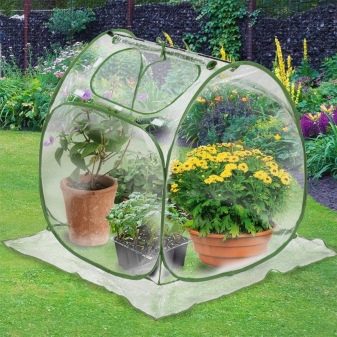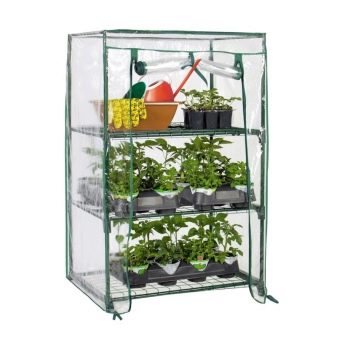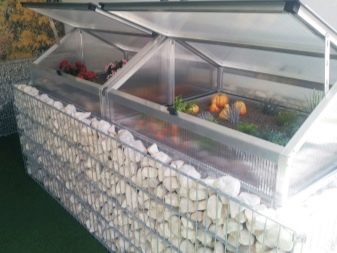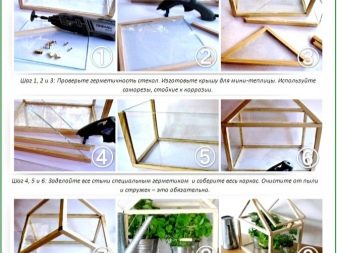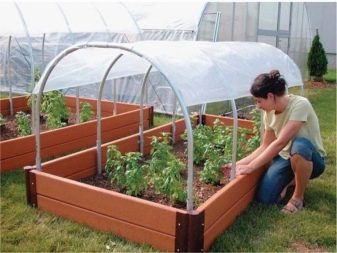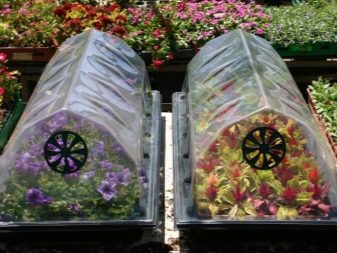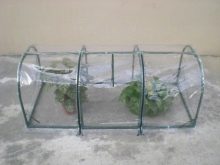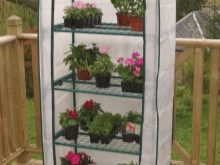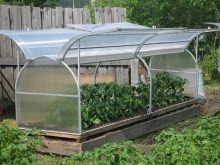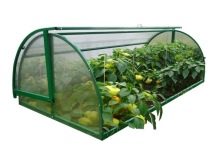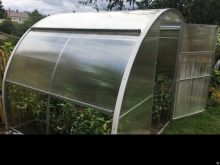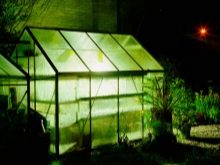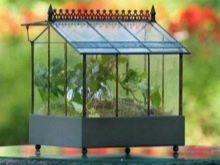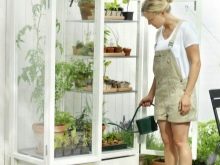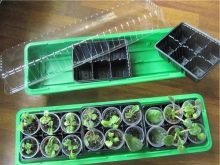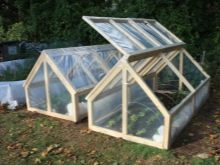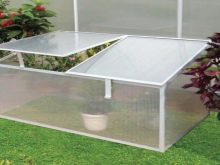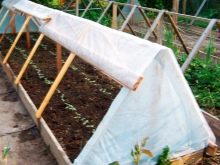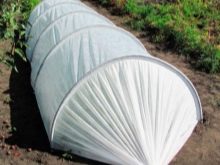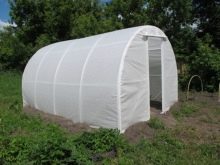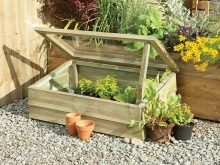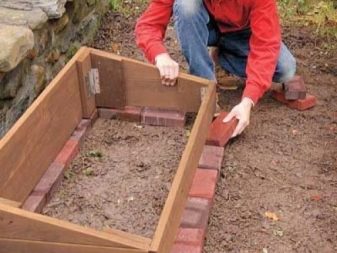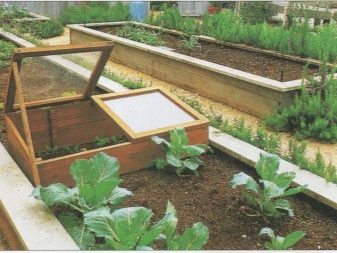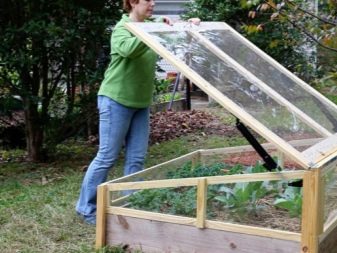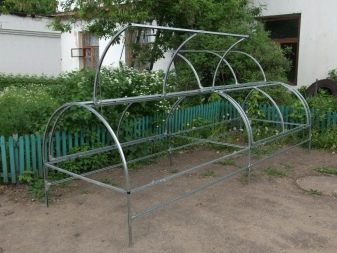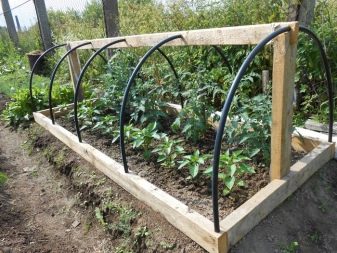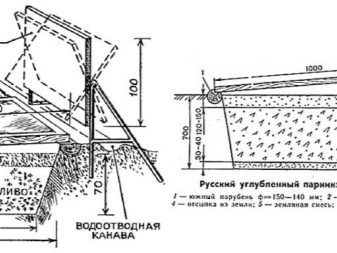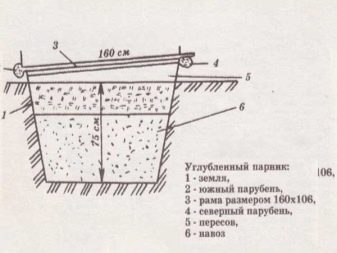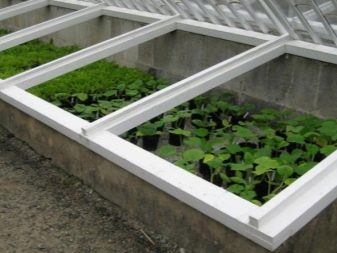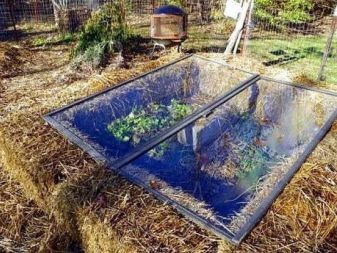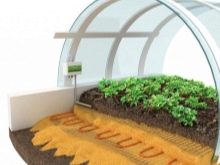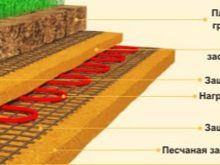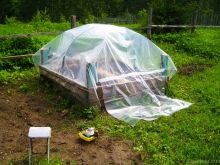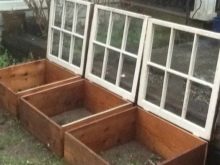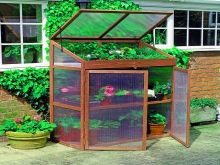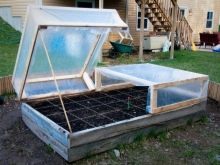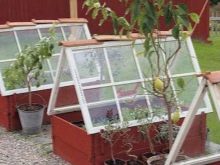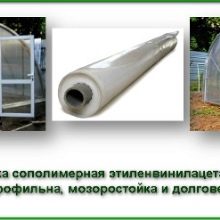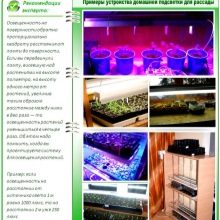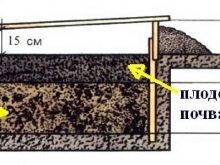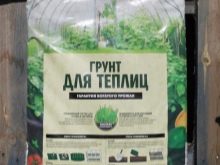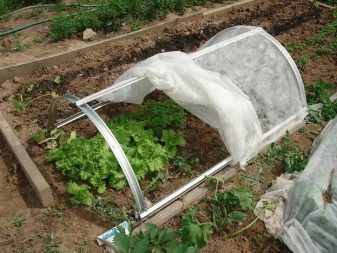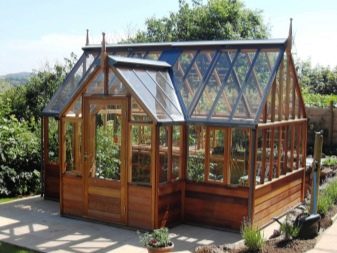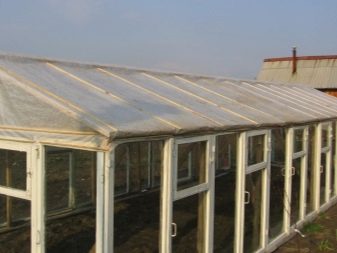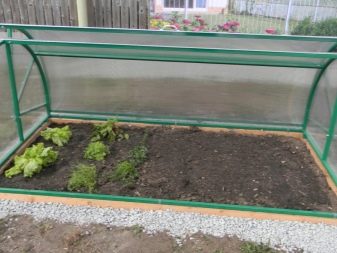Greenhouses for seedlings: types and their features
Even with a small piece of land, you can place a greenhouse on it. These designs are becoming increasingly popular. Even in apartments and houses mini-greenhouses are already appearing, not to mention full-fledged summer cottages.
Special features
For the rapid growth of early seedlings need to fulfill a lot of conditions. The most important are the parameters of the microclimate that will surround the young shoots. This problem is easily solved greenhouse. Inside this structure, a special microclimate is maintained, which contributes to the rapid growth of plants and their rapid development.
Such designs have a number of surprising features that do not leave indifferent even novice gardeners, not to mention experienced:
Mini-greenhouses attract mobility.They are easily transferred, which allows to take into account the requirements of a particular culture.
Universality regarding the choice of plant species for growing. With proper approach in the greenhouse, you can create the climate that is required by the selected plant.
- Availability of materials for self-production and low cost for the purchase of finished design. Whatever option is chosen, you still will not incur big expenses. For a homemade greenhouse in general, you can use the remnants of a building material.
Quick installation is another important advantage. A greenhouse can be done in an hour, for a more dimensional construction, you will have to spend no more than a day. Time is minimum, benefit is maximum.
Kinds
All greenhouses can be divided into two large groups: for home and garden, or street.
Street greenhouses can be monolithic, large or compact, portable structures. There are many varieties and variations. You can buy a ready-made version or create a real masterpiece on your own.
Arched country greenhouse - this is a common option that is easy to make yourself. Small arcs are installed in a row, which can be made from various materials. On top of the design is covered with a special agrofiber or a conventional film cover. Can be portable or mounted in a fixed location.
Outdoor portable miniature greenhouses have a box without bottom. On top is a glass or film cover. This garden option is easily transferred to a new place and even installed just in the garden. This design is often used to protect seedlings that have already been planted on the ground from frost. Also, this greenhouse is great for rooting the growth of garden crops.
Vertical greenhouse has enough space for the location of shelves and stands. Even the rack can be placed in this design. There are greenhouses for 4 shelves, but they are easy to make and do it yourself. These greenhouses take up little space, but at the same time allow you to grow a lot of seedlings.
Recessed design, or a Belgian greenhouse is located in a trench. A trim is created on the sides, inside which the selected crop is planted. On top is a polycarbonate or film cover.The simplest design has a cover with one ramp. For more complex and overall greenhouses a gable cover is constructed. The functions of insulation performs the ground.
Butterfly greenhouse stands out among the entire range of unusual type of opening. On top of the set small sash. When open, they look like moth wings. Theoretically, such designs can have different dimensions, but most often have a small size.
Greenhouse snail It is also called the “breadbasket”, in most cases it has large dimensions, therefore it is suitable for a spacious cottage. The appearance of the structure, in particular, the principle of opening, really resembles a breadbasket. Such constructions are selected for simple care of plantings and convenient access.
Tulip greenhouse - it is a modern large-sized construction, which is equipped with a sliding roof, doors, air vents, removable transparent panels. Everything in this building is thought out to the smallest detail. The collapsible type of construction eliminates the possibility of damage to the panels under the pressure of snow. The folding roof provides free access to the plantings and does not impedenatural irrigation.
Greenhouses with heating and lighting are necessary for the cultivation of early crops. Without this condition to grow a good harvest will not work. A warm greenhouse can be equipped with heaters with infrared lamps, heaters, heating panels. You can also lay a heat cable or, at worst, install inside a container with hot water. Biofuel is another option for equipping a warm greenhouse. You will learn more about the rules for its use below.
For home greenhouse need a compact. Often such designs are located on the windowsill. They allow early to engage in the cultivation of seedlings - in February or in early March. It all depends on the selected plant. In any case, the seeds begin to grow rapidly, and the shoots grow intensively. Often, a micro-greenhouse is created by the type of street structures, only in reduced sizes. Home greenhouse can even be multi-level, not to mention the usual arc and film options. Mini-greenhouses in specialized stores are offered in a large assortment. But with your own hands you can build a structure that will not yield to the finished version.
Manufacturing materials
For the manufacture of greenhouses used a variety of materials. We will talk further about the advantages and disadvantages of each of them.
Let's start with the materials that are used for the support and frame:
- The plastic is difficult to fold into an arc, because it retains its original shape well and can crack if it is overly stressed. But the availability of plastic material definitely wins.
- Metal is characterized by durability and strength, but corrosion remains the main problem. Metal necessarily requires processing.
- Wood for arcs is used extremely rarely, more often for the frame. When a prefabricated greenhouse is created, this material is especially relevant. The tree also needs a treatment that will protect against rotting.
Shelter materials can also be used different.
- Polycarbonate is widely used in many industries, including the production of greenhouses. This material can be used for home-made designs, since it is available and easy to use. At its core, it is a plastic material. But, unlike plastic, polycarbonate is much stronger.It is also lighter and more practical than glass.
- Polyethylene film is often used, since this option is the most simple and affordable. The process of fixing is not difficult, regardless of the material of the arcs and frame. Such material can be used a maximum of 3 seasons, taking into account its removal for the winter time. But for home greenhouses the film is the best option.
- Agrofibre is more expensive than the previous version, but it is durable and practical. There are no problems with fastening, due to the porous structure the material is permeable to moisture and retains heat.
- Spunbond is a relatively new material, which is a non-woven material. In the composition there are stabilizers that quench the negative effects of ultraviolet radiation. This feature provides material durability, despite the constant exposure to the sun. Spunbond is available with various density indicators and the presence of stabilizers.
- Reinforced with a film cover greenhouses in the area, which is characterized by strong winds. The material is able to withstand wind loads up to 34 m / s, which is an impressive figure.Also, it is not afraid of low and high temperatures (from -50 to +60). The material is multi-layered, fiberglass mesh is located inside.
- Glass is already receding into the background, since it is far from the best option for greenhouses. It is fragile, heavy, expensive, difficult to work.
How to build with your own hands?
In spring everyone can make a greenhouse for seedlings. We offer the most simple, interesting and practical options that can be created by yourself.
First you need to learn some tips that will avoid errors during operation.
- The size of the greenhouse should be carefully considered so that further exploitation and maintenance of the plants are comfortable. If a mini-greenhouse is created, then 1 x 2 m will be sufficient. The height is selected in accordance with the available boards.
- It is not recommended to mount inclined structures. On the one hand, this design allows water to flow and not linger on the surface. But on the other hand, the moisture does not interfere with plantings and one side turns out to be shaded. With a lack of sun, young shoots are thin, tall and weak.
A greenhouse made of wood can be presented in several versions: with box, frame, with window frames or with film coating.
- For the construction of the box it is necessary to prepare four boards: two for the length and width. The ends are trimmed under the square. To collect the box, you can use the bars or fasten the boards butt. The box is better strengthened by rectangular triangles, which will be located at the corners.
- Then you can go to the top. For structures that are created for long-term use, it is better to mount the frame with glass. They are made more difficult than film coating, but the process of operation will be comfortable and long.
- For a greenhouse with a two-meter length, it will be enough to make three frames. To create them will require bars - 4 for each frame. On one side you need to make a chamfer for glass. Next, prepare the glass and fix it in frames with beadings. Finished frames can be fixed at the expense of the loop, which will make further operation more convenient. In the case of using the film, you can simply fix it with small studs or lay a load around the perimeter.
- From a tree you can build a greenhouse without a box. This will be a framed tunnel structure. To implement this idea, it is necessary to mount the frame of the rails.Timber is collected at an angle, on top of the board are fixed with nails / screws.
The lower ends, which will be dug into the ground, it is better to make sharp. To increase stability, you can perform a bunch of all composite structures with the help of bars. The film will be pulled from both sides. On the one hand, it is necessary to powder it, and on the other hand, to fix it with the help of a load (stones, bricks).
Arched structures are usually made of metal. They are durable and reliable, quickly assembled and easily transferred to another place. For constructions it is necessary to choose rods with a diameter of 6–8 mm. The length depends on the expected width of the greenhouse at a height of about 50 cm. Only film or agrofibre is used for coating. Eliminate sagging material can be due to the tension of the rope between the arcs.
Plastic pipes are great for creating arched greenhouses. The main problem lies in the process of plastic bending. There are several ways to solve it. Initially, it is required to make a template according to which the arches will be created. It is possible to drive nails into the board, without forgetting about additional resistant nails along the board edges.The pipe is inserted into the template and heated with the help of a building hair dryer or boiling water. The heated pipe will easily take the desired shape. It should cool completely in this position.
Warm greenhouses - this is very convenient, because you can start growing seedlings in February or with the onset of spring and not to abandon early crops. Different equipment can be used in warm greenhouses, but it is better to choose biofuel as the most effective and inexpensive option.
The work is carried out according to the following scheme.
- A trench is being dug, the depth of which is determined by the month the fuel was laid. At least 70 cm is required for March, 50 cm will be sufficient for April.
- The prepared pit is filled with fuel, which is best used as manure.
- On top of the pit is a film and mats. After some time, the manure will heat up, you need to add new fuel to the original level.
- On the edge of the trench are laid couplers - logs or boards. On the south side, the parables are simply laid on the ground, and on the north side they rise 10 cm. The top of the greenhouse frame is laid on top.
- In a week, the fuel will warm up well, as evidenced by steam. At this time, the top can fill the soil with the addition of ash and lime.
A warm greenhouse can also be made with the help of artificial heating, for example, a special cable.
The scheme of work will be as follows:
- the bottom of the greenhouse is covered with gravel and sand;
- on top of the gravel-sand pillow is laid cable snake;
- to protect the heating element, you can put the boxes of cast iron or iron sheets;
- now comes the fertile layer, its thickness should be about 18 cm;
- the system is connected to the network, the voltage of 220V will be quite enough.
Of the many materials at hand can make a greenhouse. For example, a regular box, covered with foil, will already be a good greenhouse. The box can be replaced, for example, with a barrel. Under any old frame with glass you can knock down the frame. Several frames, put the house - and the greenhouse is ready. It remains only to beat the side of the film. For home mini-greenhouses you can adjust the closing trays with eggs.
Tips
Often there are situations when the greenhouse on the site is installed, and what to do with it next is not known.One must be able to use such constructions, otherwise one can spoil all undertakings.
Different crops require different conditions (temperature of soil and air, light, humidity). Expanding the existing structure or planting all crops should not be planted in one greenhouse. It is better not to be lazy and make a few greenhouses.
When choosing a place for a greenhouse, preference should be given to smooth and quiet areas. You can even choose a playground in the garden. During the growth of seedlings on the trees, the leaves are small, so the shadow of them will not close the sun. The greenhouse should be located conveniently so that the process of its operation was convenient. There should be a source of water, a barn with tools and other useful facilities nearby.
When choosing a film for shelter, it is imperative to study the parameters that all responsible manufacturers apply to it.
The soil is recommended to warm up before planting seeds. To speed up this process, it can be covered with ash or peat. This way more solar energy will be absorbed. In addition, both ash and peat are excellent fertilizer.
With a lack of sun in the greenhouse you need to do artificial lighting.Shelves and racks are created inside vertical greenhouses, which save space and create an additional bed.
There are a number of tips that relate to the preparation of the soil for use in greenhouses. Wrong soil can seriously spoil the whole idea, the seeds may not germinate at all or the plants will be weak.
The soil is prepared according to the following rules.
- Good soil should be light, rich in organic and mineral components.
- The soil must contain peat. Good soil is obtained from the following ratio: three parts of peat are taken on one part of the sod, foliage (preferably forest) and humus.
- Components for future soil are harvested in the fall, and mixed before planting seeds. Packages are used to store composite components. The temperature in the room should not fall below zero.
- The soil must be decontaminated. For this you can use fumigation, steaming, apply antiseptics or copper sulfate. Most of these methods require the use of personal protective equipment.
Beautiful examples
This greenhouse is mobile, reliable, quickly assembled and easily transferred to a new location.The frame does not create difficulties in the care of plantings. Such a greenhouse requires a minimum of investment, effort and time.
This greenhouse can be called a work of art and the dream of many. Any owner of a household would not mind to acquire such a frame greenhouse. One of the disadvantages is the complexity of growing crops with different requirements for environmental conditions.
This beautiful greenhouse was created with its own hands, it can be said, from scrap materials. But while he looks very beautiful. If to understand, then the most difficult stage is the bending of plastic pipes. All other processes are easy, do not require the use of complex tools and the use of special skills. Everyone will be able to build the same design for their site.
Polycarbonate was used for this greenhouse - durable and reliable material that can last for many years. The design itself is built on the principle of breadbox. It is easy to use, looks beautiful and provides free access to plantations. You can make such a construction yourself, but you have to spend a lot on materials, clearly calculate the dimensions and give the metal bars the desired shape.
How to make a greenhouse for seedlings with your own hands, see the following video.

